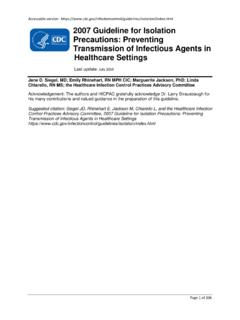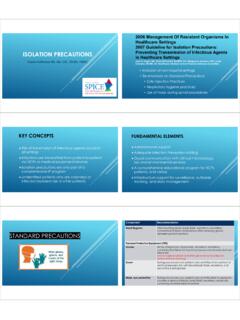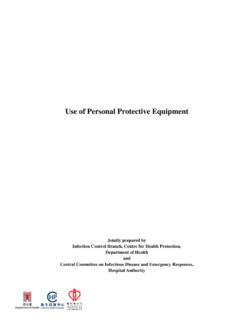Transcription of Infection Control: The Basics - Relias
1 Infection Control: The Basics Section 1: Introduction About This Course Healthcare-associated infections are a serious issue in healthcare. On any given day, approximately 1 in 25 hospitalized patients have a healthcare-associated Infection , and over 750,000 of these infections result in death (Magill et al., 2014). Astounding, isn't it? And these numbers don't account for infections acquired in other healthcare settings. preventing the transmission of infections from one person to another is critical. In this course, you will learn about the Basics of Infection control. Learning Objectives After taking this course, you should be able to: Sequence the components in the chain of Infection .
2 Differentiate between each of the four methods of transmission. Apply standard and transmission-based precautions . Section 2: Concepts of Infection Control To prevent the spread of Infection , you must be familiar with the chain of Infection and the steps to break this chain. The Chain of Infection A specific set of conditions must exist in a specific sequence for an Infection to spread. Agent = The chain begins with an infectious agent, such as bacteria, fungi, parasites, or viruses. Reservoir = The place where the agent lives, grows, and multiplies. It may be a human, animal, or even the environment. Portal of exit = The path by which the infectious agent leaves its host.
3 This could be through the nose, mouth, or in blood or body fluids. Method of transmission = The way the agent travels from the reservoir to the host, which may include direct and indirect contact, droplet, and airborne transmission. Portal of entry = The manner in which the agent enters the host. This may be through a mucous membrane, such as the eyes, nose, or mouth, or through non-intact skin. Susceptible host = A person who is unable to resist the invasion of an infectious agent. Source: Centers for Disease Control and Prevention (CDC), 2011. 2020 Relias LLC. All rights reserved. Page | 1. Course Title The following scenario illustrates the chain of Infection . Can you identify each of the six links?
4 Mary wakes up this morning feeling a bit under the weather. Not knowing that she has the rhinovirus, a virus that causes the common cold, she goes to work as usual. She doesn't want to miss her interview with Samantha from HR about the open position she applied for. Before her interview, Mary blows her runny nose one last time then heads to Samantha's office. Mary enthusiastically shakes Samantha's hand while thanking her for the interview. After the interview, Samantha decides to eat lunch while reviewing the candidates for the new position. Engrossed in the decision ahead of her, Samantha fails to wash her hands before eating. Three days later, Samantha is sick at home with a sore throat, runny nose, and a fever.
5 infectious agent = Rhinovirus Reservoir = Mary Portal of Exit = Nose Method of Transmission: Contact with the infected person Portal of Entry = Mouth Susceptible Host = Samantha Feedback: The rhinovirus is the infectious agent. Mary is the reservoir. Mary's nose is the portal of exit. The handshake between Mary and Samantha is the method of transmission. Samantha is the susceptible host and Samantha's mouth is the portal of entry. Methods of Transmission Infection control involves implementing steps to break the chain of Infection , usually by stopping transmission of the infectious agent. The CDC (2007) identifies four methods of transmission . direct contact, indirect contact, droplet, and airborne.
6 Q1: Remember Mary and Samantha? How was the rhinovirus transmitted from Mary to Samantha? A) Direct contact B) Indirect contact C) Droplet D) Airborne Feedback: This scenario represents direct contact. It requires direct physical contact with an infected person or infected blood or body fluids. infectious diseases transmitted this way include MRSA, HIV, Hepatitis B and C, and gonorrhea. 2020 Relias LLC. All rights reserved. Page | 2. Course Title Q2: What if Mary sneezed during her interview with Samantha? How would the rhinovirus have been transmitted? A) Direct contact B) Indirect contact C) Droplet D) Airborne Feedback: This scenario represents droplet transmission.
7 It involves the travel of respiratory droplets over a short distance to the mucosal surfaces of the susceptible host. It's usually the result of someone sneezing, coughing, or talking, but could also occur during certain medical procedures such as suctioning and CPR. In addition to the common cold, other infectious diseases transmitted this way include influenza and pertussis. Remember, the proper way to sneeze is to do so in your elbow, not your hands. This is one way to break the chain of Infection . Q3: What if Samantha contracted the rhinovirus after Mary coughed into her hands then used Samantha's pen? How would the rhinovirus have been transmitted? A) Direct contact B) Indirect contact C) Droplet D) Airborne Feedback: This scenario represents indirect contact.
8 It involves contact with a contaminated object or surface, or contact with a person other than the infected person (for example, contact with the hands of a healthcare worker who did not perform hand hygiene after touching an infected person or object). Remember, the proper way to cough is to do so in your elbow, not your hands. This is one way to break the chain of Infection . Q4: What if Mary had active tuberculosis instead of the common cold? How is tuberculosis spread? A) Direct contact B) Indirect contact C) Droplet D) Airborne Feedback: Tuberculosis is transmitted by airborne transmission. Airborne transmission is different from droplet transmission in that a person does not have to have close contact with the infected person to be exposed to the infectious agent.
9 infectious agents spread through airborne transmission can travel through the air over long distances before being inhaled by the susceptible host. Thankfully, few infectious diseases are transmitted this way, but included are the measles and chickenpox. 2020 Relias LLC. All rights reserved. Page | 3. Course Title Standard precautions Remember, breaking any one of the links in the chain of Infection will stop the spread of the Infection . The measures that you take to stop the transmission of infectious agents, thereby breaking the chain of Infection , are called standard precautions . Standard precautions are based on the principle that all blood, body fluids, secretions, excretions, non-intact skin, and mucous membranes may contain transmissible infectious agents (CDC, 2007).
10 Standard precautions include proper hand hygiene, the use of personal protective equipment, and the appropriate cleaning and handling of equipment, environmental surfaces, and laundry. Transmission-Based precautions Sometimes, the use of standard precautions alone is not enough to prevent the spread of Infection . In these cases, the addition of transmission-based precautions is needed. The three transmission-based precautions , which correlate to the method of transmission of an infectious agent, are contact, droplet, and airborne. Persons requiring transmission-based precautions should be placed in a private room if possible. Q1: Your co-worker Nathan asks you what precautions he should take if he has to take the temperature of someone on contact precautions because of infectious diarrhea.







